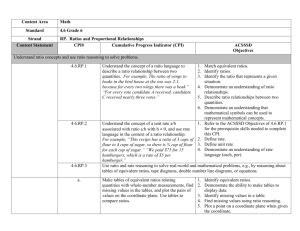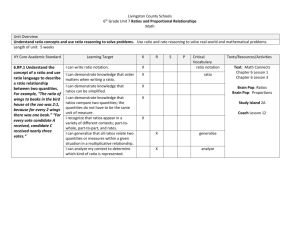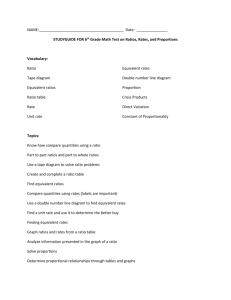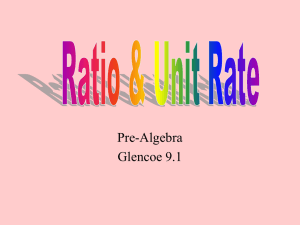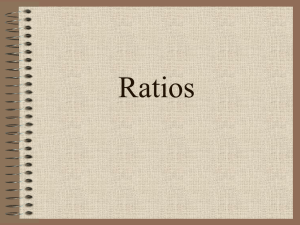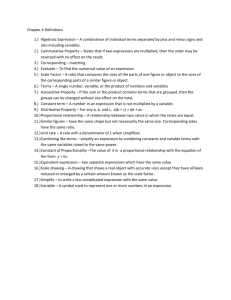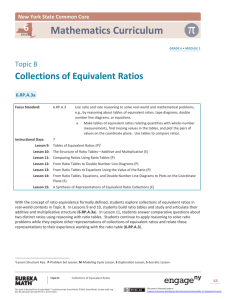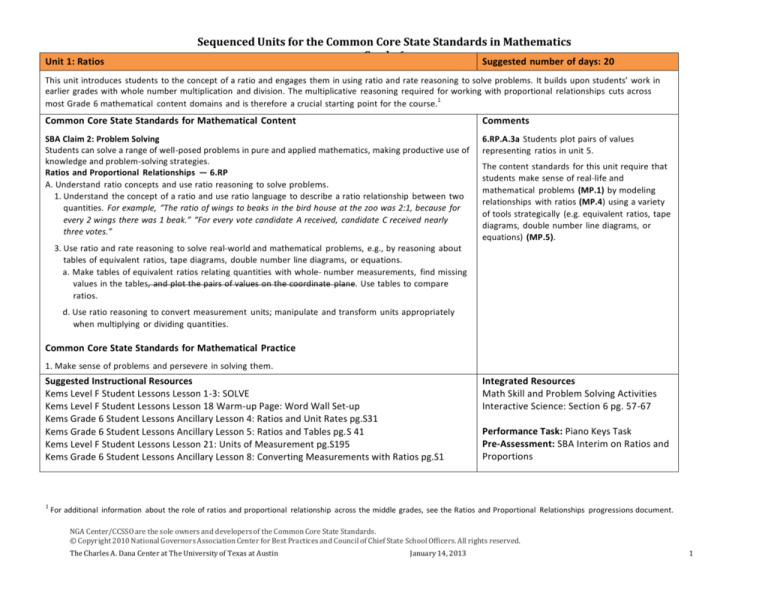
Unit 1: Ratios
Sequenced Units for the Common Core State Standards in Mathematics
Grade 6
Suggested number of days: 20
This unit introduces students to the concept of a ratio and engages them in using ratio and rate reasoning to solve problems. It builds upon students’ work in
earlier grades with whole number multiplication and division. The multiplicative reasoning required for working with proportional relationships cuts across
1
most Grade 6 mathematical content domains and is therefore a crucial starting point for the course.
Common Core State Standards for Mathematical Content
Comments
SBA Claim 2: Problem Solving
Students can solve a range of well-posed problems in pure and applied mathematics, making productive use of
knowledge and problem-solving strategies.
Ratios and Proportional Relationships — 6.RP
A. Understand ratio concepts and use ratio reasoning to solve problems.
1. Understand the concept of a ratio and use ratio language to describe a ratio relationship between two
quantities. For example, “The ratio of wings to beaks in the bird house at the zoo was 2:1, because for
every 2 wings there was 1 beak.” “For every vote candidate A received, candidate C received nearly
three votes.”
6.RP.A.3a Students plot pairs of values
representing ratios in unit 5.
The content standards for this unit require that
students make sense of real--‐life and
mathematical problems (MP.1) by modeling
relationships with ratios (MP.4) using a variety
of tools strategically (e.g. equivalent ratios, tape
diagrams, double number line diagrams, or
equations) (MP.5).
3. Use ratio and rate reasoning to solve real--‐world and mathematical problems, e.g., by reasoning about
tables of equivalent ratios, tape diagrams, double number line diagrams, or equations.
a. Make tables of equivalent ratios relating quantities with whole-‐‐ number measurements, find missing
values in the tables, and plot the pairs of values on the coordinate plane. Use tables to compare
ratios.
d. Use ratio reasoning to convert measurement units; manipulate and transform units appropriately
when multiplying or dividing quantities.
Common Core State Standards for Mathematical Practice
1. Make sense of problems and persevere in solving them.
Suggested
Instructional
Resources
4.
Model with
mathematics.
Kems
Level
F
Student
Lessons
Lesson 1-3: SOLVE
5. Use appropriate tools strategically.
Kems Level F Student Lessons Lesson 18 Warm-up Page: Word Wall Set-up
Kems Grade 6 Student Lessons Ancillary Lesson 4: Ratios and Unit Rates pg.S31
Kems Grade 6 Student Lessons Ancillary Lesson 5: Ratios and Tables pg.S 41
Kems Level F Student Lessons Lesson 21: Units of Measurement pg.S195
Kems Grade 6 Student Lessons Ancillary Lesson 8: Converting Measurements with Ratios pg.S1
1
Integrated Resources
Math Skill and Problem Solving Activities
Interactive Science: Section 6 pg. 57-67
Performance Task: Piano Keys Task
Pre-Assessment: SBA Interim on Ratios and
Proportions
For additional information about the role of ratios and proportional relationship across the middle grades, see the Ratios and Proportional Relationships progressions document.
NGA Center/CCSSO are the sole owners and developers of the Common Core State Standards.
© Copyright 2010 National Governors Association Center for Best Practices and Council of Chief State School Officers. All rights reserved.
The Charles A. Dana Center at The University of Texas at Austin
January 14, 2013
1

